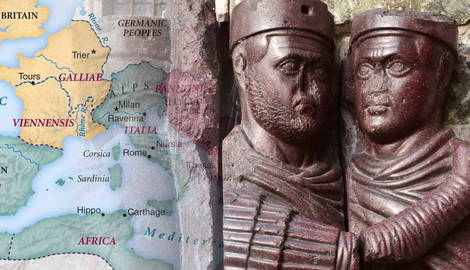
To resolve the issue of uneasy imperial succession, prevent bloody civil wars, and facilitate the management of the vast territory, Emperor Diocletian established the Tetrarchy. This was the answer to the so-called Third-century crisis, a chaotic period for the Roman Empire, during which no less than twenty-four emperors exchanged at the throne and at least sixty men tried to claim it. The problem was that few could unify the Empire and restore its stability. Even those who managed to achieve such a difficult task, like Emperor Aurelian, rarely kept the throne for long. Thus, emperor Diocletian instituted the rule of four – the Tetrarchy. This new form of government radically changed the Roman Empire’s shape, briefly restoring its stability. But, while initially, the system worked as intended, it did not take long for ambitious men to break it, plunging the Roman Empire into another civil war.
Diocletian and Creation of the Tetrarchy

Diocletian rise to power was typical of his period. Born in the province of Dalmatia (modern-day Croatia), Diocletian joined the army and quickly rose through the ranks. Thus, when emperor Carus died in 284 CE, the legions proclaimed Diocletian as his successor. Diocletian’s claim was, however, challenged by Carinus, the late emperor’s son, and the civil war ensued, in which Diocletian was victorious. In 285, Diocletian became the sole master of the Roman Empire. The new emperor immediately embarked on a series of reforms, including finances, military, and administration. His most important reform, however, was the reshaping of government. Aware that one man alone cannot rule the vast territory and respond to the numerous challenges that the Empire faced, Diocletian instituted first the rule of two (Dyarchy), only to replace it with the rule of four – the Tetrarchy.
Tetrarchy – The Rule of Four

Soon after ascending to the throne in 287, Diocletian appointed another distinguished general and his close colleague – Maximian – as his co-emperor (Augustus). This was highly unusual, a precedent in the Roman Empire, as Maximian was not Diocletian’s relative but was chosen based on merit. The two men shared their power. Diocletian assumed control over the East, while Maximian ruled in the West. However, the two men continued to be challenged by usurpers. For this reason, Diocletian established the Tetrarchy – the “rule of four.” By appointing two more junior emperors (Caesares), again based on merit, Diocletian hoped to avoid further usurpation. Thus, the death of one of the Tetrarchs would not lead to the destabilization of the government, and the Empire’s unity was kept intact.
The First Four Tetrarchs

The four competent rulers, each governing their part of the Empire, had an easier time dealing with various challenges, both external and internal. Diocletian ruled over Asia Minor, Egypt, Syria and Mesopotamia. Maximian governed Italy, Spain and Africa. Diocletian’s junior emperor, caesar Galerius, controlled the Balkans and Pannonia, while caesar Constantius Chlorus managed the provinces in Gaul and Britain.
To further strengthen their relationship, the senior emperors officially adopted the juniors. Their families also intermarried, creating strong bonds displayed in the imperial coinage, edicts and statuary. However, the delegation of power was not permanent. In 305, Diocletian made another precedent in Roman history by abdicating and retiring to his palatial villa near Salona (modern-day Split). Maximian followed suit, passing the torch to Galerius and Constantius. Their place, now vacant, was filled by the new caesares Severus and Maximinus Daza. Diocletian’s system worked. But not for long.
The First Cracks

Diocletian and Maximian had peacefully retired, but their influence in the Roman Empire remained strong. The new augusti continued to follow the policies of their predecessors. Unfortunately, after the sudden death of Constantius Chlorus in 306, his legions chose Constantius’ son, Constantine, as the new emperor. As a result, the Diocletian’s Tetrarchy, which at all costs avoided succession by bloodline, began to falter. More cracks appeared after Maximinus’ son Maxentius took the purple. His father supported Maximian, and together they defeated and executed emperor Severus. The Tetrarchy continued to crumble as Maxentius, who now ruled Italy, entered into open conflict with his rival Constantine, culminating in the famous Battle of the Milvian Bridge in 312 and Maxentius’ drowning in the Tiber.
The Fall of the Tetrarchy

The death of Maxentius left the empire in the hands of Constantine and his co-emperor in the East, Licinius. At first, the two kept an uneasy alliance, each managing their part of the Empire. In 313, the two emperors even met in Milan and jointly recognized Christianity as one of the official religions of the Empire. However, it did not take long for another civil war to flare up. Finally, in 324, following the defeat of Licinius, Constantine the Great became the sole master of the Roman Empire, effectively ending the Tetrarchy.










